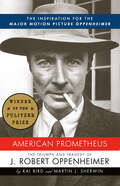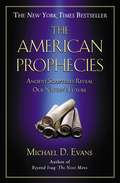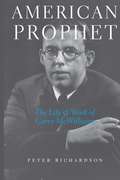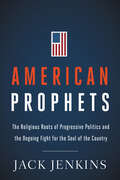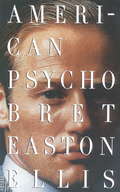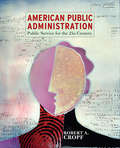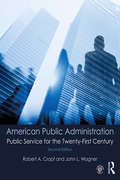- Table View
- List View
American Prisoners Of Japan: Did Rank Have Its Privilege?
by Major Michael A. Buffone ZarateThis thesis examines the story of American POWs held by the Japanese in WWII to see if there were significant differences in treatment based on rank. It examines how the Japanese treated the prisoners according to international law and also distinctions made by the officers themselves simply because of higher rank.The thesis begins by discussing the historical framework for POW rank distinctions by looking at past wars and the development of rank distinctions in international rules. It then covers the American WWII POW experience in the Far East from Bataan and Corregidor to the war's end.Special emphasis is placed on distinctions made in food, housing, pay, medical care, camp administration, work requirements, escape opportunities, transportation, leadership problems, and overall death rates.The study concludes that there were significant differences in treatment based on rank. These differences caused extremely high enlisted death rates during the first year of captivity. The officers fared worse as a group, however, because the Japanese held them in the Philippines until late 1944 because international rules prevented the Japanese from using officers in Japan's labor camps. During shipment to Japan many officers died when the unmarked transport ships were sunk by advancing American forces.
American Prisons: Their Past, Present and Future
by David Musick Kristine Gunsaulus-MusickImprisonment has become big business in the United States. Using a "history of ideas" approach, this book examines the cultural underpinnings of prisons in the United States and explores how shared ideas about imprisonment evolve into a complex, loosely connected nationwide system of prisons that keeps enough persons to populate a small nation behind bars, razor wire and electrified fences. Tracing both the history of the prison and the very idea of imprisonment in the United States, this book provides students with a critical overview of American prisons and considers their past, their present and directions for the future. Topics covered include: • a history of imprisonment in America from 1600 to the present day; • the twentieth-century prison building binge; • the relationship between U.S. prisons and the private sector; • a critical account of capital punishment; • less-visible prison minorities, including women, children and the elderly; and • sex, violence and disease in prison. This comprehensive book is essential reading for advanced courses on corrections and correctional management and offers a compelling and provocative analysis of the realities of American penal culture from past to present. It is perfect reading for students of criminal justice, corrections, penology and the sociology of punishment.
American Privacy: The 400-year History of Our Most Contested Right
by Frederick S. LaneA page-turning narrative of privacy and the evolution of communication, from broken sealing wax to high-tech wiretapping.
American Pro: The True Story of Bike Racing in America
by Jamie SmithAmerican cycling has a long tradition of riding and racing on a shoestring and a prayer. Jamie Smith explores the domestic side of the world&’s biggest amateur sport in American Pro: The True Story of Bike Racing in America. American Pro rips away the thin veneer of professionalism among domestic racing teams to lay bare the heart and soul of a struggling sport. Smith traces the arc of one team&’s racing career to discover colorful personalities, scrappy racing action, humor and heartbreak. American Pro shows what the sport demands: the scramble for contracts, the dynamics of team chemistry, the unending travel, the Herculean struggle to realize the dreamall for the love of bike racing. With sharp humor and insight, Smith uncovers what&’s wrongand what&’s rightwith America&’s broken bike racing system. American Pro will transform how you think of domestic pro racing through a five-season exposé of the sport we love.
American Profile Hometown Cookbook: A Celebration of America's Table
by Mary Carter Susan Fisher Candace Floyd"In this extraordinary cookbook, you'll find traditional American favorites with a unique twist alongside ethnic creations from around the world. Also included are helpful tips from American Profile's test kitchen as well as 30 articles on hometown festivals and fairs across the nation that give you a sneak peek into the lives of the ordinary citizens that make up hometown America. Whether it's a simple soup for the family or a full meal for visitors, the American Profile Hometown Cookbook has just the right recipe to make any gathering a special occasion."
American Profile Hometown Cookbook: A Celebration of America's Table
by Mary Carter Susan Fisher Candace FloydDiscover the many flavors of hometown America with American Profile’s cookbook featuring more than four hundred family recipes, plus stories, articles, and more.Dedicated to celebrating American hometown life, American Profile has always invited readers to share their favorite recipes, along with the stories behind them. This cookbook collects more than four hundred of the most memorable and delicious entries. Here are real American recipes passed from generation to generation, traded among dear friends, or created to meet the needs of a family on a budget.In this extraordinary cookbook, you’ll find classic favorites with a unique twist alongside ethnic creations from around the world, such as Apple-Sausage Pancakes, Tamale Soup, Chicken Dumplings, Aunt Lillian’s Pumpkin Bread, Tiramisu Torte, and many others. Also included are helpful tips from American Profile’s test kitchen as well as thirty articles on hometown festivals and fairs across the nation. Whether it’s a simple soup for the family or a full meal for visitors, the American Profile Hometown Cookbook has just the right recipe to make any gathering a special occasion.
American Progressivism: A Reader
by Ronald J. Pestritto William J. AttoAmerican Progressivism is a one-volume edition of some of the most important essays, speeches, and book excerpts from the leading figures of national Progressivism. It is designed for classroom use, includes an accessible interpretive essay, and introduces each selection with a brief historical and conceptual background. The introductory essay is written with the student in mind, and addresses the important characteristics of Progressive thought and the role of Progressives in the development of the American political tradition. Students of American political thought, American politics, American history, the presidency, Congress, and political parties will find this reader to be an invaluable source for insight into Progressivism.
American Project
by Sudhir Alladi VenkateshVenkatesh provides a captivating story on the rise and fall of a modern ghetto.
American Prometheus: The Inspiration for the Major Motion Picture OPPENHEIMER
by Kai Bird Martin J. SherwinTHE INSPIRATION FOR THE MAJOR MOTION PICTURE OPPENHEIMER • "A riveting account of one of history&’s most essential and paradoxical figures.&”—Christopher Nolan#1 NEW YORK TIMES BESTSELLER • PULITZER PRIZE WINNER • The definitive biography of J. Robert Oppenheimer, one of the iconic figures of the twentieth century, a brilliant physicist who led the effort to build the atomic bomb for his country in a time of war, and who later found himself confronting the moral consequences of scientific progress.In this magisterial, acclaimed biography twenty-five years in the making, Kai Bird and Martin Sherwin capture Oppenheimer&’s life and times, from his early career to his central role in the Cold War. This is biography and history at its finest, riveting and deeply informative.&“A masterful account of Oppenheimer&’s rise and fall, set in the context of the turbulent decades of America&’s own transformation. It is a tour de force.&” —Los Angeles Times Book Review&“A work of voluminous scholarship and lucid insight, unifying its multifaceted portrait with a keen grasp of Oppenheimer&’s essential nature.... It succeeds in deeply fathoming his most damaging, self-contradictory behavior.&” —The New York Times
American Promise: Equal Justice and Economic Opportunity
by Arthur I. BlausteinThis forcefully argued and carefully documented report by the National Advisory Council on Economic Opportunity criticizes the Reagan Economic Recovery Program on the basis that it separates economic theory from social policy, pursuing the former at the expense of the latter, which hurts the poor and could lead to social chaos. This controversial volume also argues that the current policy proposals for the 1980s ignore national standards of responsi-bility and accountability.The report focuses on five aspects of American social, economic, and po-litical life: unemployment and inflation; federal antipoverty programs and policies; the changing face of poverty and the myths that affect the poor; the role of voluntary associations and the shared moral values of our society; the particular problems of family, child care, and welfare for women in poverty.
American Property: A History of How, Why, and What We Own
by Stuart BannerIn America, we are eager to claim ownership: our homes, our ideas, our organs, even our own celebrity. But beneath our nation's proprietary longing looms a troublesome question: what does it mean to own something? More simply: what is property? The question is at the heart of many contemporary controversies, including disputes over who owns everything from genetic material to indigenous culture to music and film on the Internet. To decide if and when genes or culture or digits are a kind of property that can be possessed, we must grapple with the nature of property itself. How does it originate? What purposes does it serve? Is it a natural right or one created by law? Accessible and mercifully free of legal jargon, American Property reveals the perpetual challenge of answering these questions, as new forms of property have emerged in response to technological and cultural change, and as ideas about the appropriate scope of government regulation have shifted. This first comprehensive history of property in the United States is a masterly guided tour through a contested human institution that touches all aspects of our lives and desires.
American Prophecies: Ancient Scriptures Reveal Our Nation's Future
by Michael D. EvansHow is America tied into ancient biblical prophecies? According to author Michael Evans, a fundamentalist Christian minister, biblical prophets already predicted that America is doomed to collapse unless its government stops accommodating the Arab world for the sake of oil and instead offers full military and diplomatic support to Israel. He believes that God wants Israel to have full control of the West Bank and Gaza, and Americans are risking God's wrath by not fully supporting this biblical mandate. Evans also theorizes that much of America's problems--including the attack of 9-11--are indications of God's fury over America's split allegiance between the two famous descendents of Abraham: Ishmael and Isaac. "We are caught in a tug of war between two brothers--between oil, political expedience, and conscience in many ways--and it our decisions and polices concerning these two brothers that will determine whether the United States will survive or go the way of the Roman Empire," he writes. Evans's prophetic foundation begins with the parable of the fig tree (Matthew 24:32-44), in which he interprets the various signs Jesus gave his disciples to mark "the final age and his return." Obviously, the Bible can be interpreted many ways, and Evans uses 17 chapters to weave in interpretations of scripture that support his theory that America faces a mammoth choice--ruin or salvation. Although actual quotes from scripture are rather sparse throughout the book, he concludes with a five-page index of "Ancient Prophecies" that indirectly support his theory. One caveat--Evans (Beyond Iraq) does not hide his vehement anti-Muslim leanings. This book will probably be offensive to Christians who practice religious tolerance and lean toward a more-inclusive solution to American diplomacy in the Middle East. --Gail Hudson
American Prophet: The Life & Work of Carey McWilliams
by Peter RichardsonA long-overdue book on the brilliant life and career of one of our greatest public intellectuals, American Prophet will introduce Carey McWilliams to a new generation of readers. Peter Richardson's absorbing and elegantly paced book reveals a figure thoroughly engaged with the issues of his time. Deftly interweaving correspondence, diary notes, published writings, and McWilliams's own and others' observations on a colorful and influential cast of characters from Hollywood, New York, Washington, DC, and the American West, Richardson maps the evolution of McWilliams's personal and professional life. Among those making an appearance are H. L. Mencken (McWilliams's mentor and role model), Louis Adamic, John Fante, Robert Towne, Richard Nixon, Studs Terkel, J. Edgar Hoover, Arthur Schlesinger, Jr., and Joseph McCarthy. American Prophet illustrates the arc of McWilliams's life and career from his early literary journalism through his legal and political activism, his stint in state government, and his two decades as editor of the Nation. This book makes the case for McWilliams's place in the Olympian realm of our most influential and prescient political writers.
American Prophets: Seven Religious Radicals and Their Struggle for Social and Political Justice
by Albert J. RaboteauAmerican Prophets sheds critical new light on the lives and thought of seven major prophetic figures in twentieth-century America whose social activism was motivated by a deeply felt compassion for those suffering injustice.In this compelling and provocative book, acclaimed religious scholar Albert Raboteau tells the remarkable stories of Abraham Joshua Heschel, A. J. Muste, Dorothy Day, Howard Thurman, Thomas Merton, Martin Luther King, Jr., and Fannie Lou Hamer--inspired individuals who succeeded in conveying their vision to the broader public through writing, speaking, demonstrating, and organizing. Raboteau traces how their paths crossed and their lives intertwined, creating a network of committed activists who significantly changed the attitudes of several generations of Americans about contentious political issues such as war, racism, and poverty. Raboteau examines the influences that shaped their ideas and the surprising connections that linked them together. He discusses their theological and ethical positions, and describes the rhetorical and strategic methods these exemplars of modern prophecy used to persuade their fellow citizens to share their commitment to social change.A momentous scholarly achievement as well as a moving testimony to the human spirit, American Prophets represents a major contribution to the history of religion in American politics. This book is essential reading for anyone who is concerned about social justice, or who wants to know what prophetic thought and action can mean in today's world.
American Prophets: The Religious Roots of Progressive Politics and the Ongoing Fight for the Soul of the Country
by Jack Jenkins“[A] thoroughly reported [and] revelatory history about the intersection of progressive politics and religion in America” (Publishers Weekly).Since the 1970s, the Religious Right has established itself as a coalition of fundamentalist powerbrokers who set the standard for Christian political values. But, as religion reporter Jack Jenkins contends, the country is also driven by a vibrant, long-standing moral force from the left. Taking many forms and many names, the Religious Left has operated since America’s founding—praying, and protesting for progressive values such as abolition, labor reform, civil rights, environmental preservation.In American Prophets, Jenkins examines the re-emergence of progressive faith-based activism, detailing its origins and contrasting its goals with those of the Religious Right. Today’s rapidly expanding interfaith coalition — which includes Christians, Jews, Muslims, Buddhists, and other faiths — has become a force within the larger “resistance” movement. Jenkins profiles Washington political insiders—including former White House staffers and faith outreach directors for the campaigns of Barack Obama, John Kerry, and Hillary Clinton—as well as a new generation of progressive faith leaders, including:Linda Sarsour, co-chair of the Women’s MarchRev. Traci Blackmon, a pastor near Ferguson, Missouri, who lifts up black liberation efforts across the countrySister Simone Campbell, head of the Catholic social justice lobby and the “Nuns on the Bus” tour organizerNative American “water protectors” who demonstrated against the Dakota Access Pipeline in Standing RockBishop Gene Robinson, the first openly gay Episcopal bishop
American Protest Literature
by Zoe TroddAmerican Protest Literature presents sources from eleven protest movements-political, social, and cultural-from the Revolution to abolition to gay rights to antiwar protest. Each section reprints documents from the original phase of the movement as well as evidence of its legacy in later times. Informative headnotes place the selections in historical context and draw connections with other writings within the anthology and beyond. Sources include a wide variety of genres-pamphlets, letters, speeches, sermons, legal documents, poems, short stories, photographs, posters-and a range of voices from prophetic to outraged to sorrowful, from U. S. Presidents to the disenfranchised. Together they provide an enlightening and inspiring survey of this most American form of literature.
American Protest Literature (The John Harvard library #99)
by Howard Zinn“I like a little rebellion now and then”—so wrote Thomas Jefferson to Abigail Adams, enlisting in a tradition that throughout American history has led writers to rage and reason, prophesy and provoke. This is the first anthology to collect and examine an American literature that holds the nation to its highest ideals, castigating it when it falls short and pointing the way to a better collective future.American Protest Literature presents sources from eleven protest movements—political, social, and cultural—from the Revolution to abolition to gay rights to antiwar protest. Each section reprints documents from the original phase of the movement as well as evidence of its legacy in later times. Informative headnotes place the selections in historical context and draw connections with other writings within the anthology and beyond. Sources include a wide variety of genres—pamphlets, letters, speeches, sermons, legal documents, poems, short stories, photographs, posters—and a range of voices from prophetic to outraged to sorrowful, from U.S. Presidents to the disenfranchised. Together they provide an enlightening and inspiring survey of this most American form of literature.
American Protestant Theology
by Luigi Giussani Damian BacichIn American Protestant Theology, Luigi Giussani traces the history of the most meaningful theological expressions and the cultural significance of American Protestantism, from its origins in seventeenth-century Puritanism to the 1950s. Giussani clarifies and assesses elements of Protestantism such as the democratic approach to Church-State relations, "The Great Awakening," Calvinism and Trinitarianism, and liberalism. His rich references and analytical descriptions reconstruct an overview of the development of a religion that has great importance in the context of spiritual life and American culture. He also displays full respect for the religious depth from which Protestantism was born and where it can reach, and expresses great admiration for its most prominent thinkers and spiritual leaders, including Jonathan Edwards, Horace Bushnell, Walter Rauschenbusch, Reinhold Niebuhr, and Paul Tillich. Further testament to Giussani's clear-minded and comprehensive knowledge of Christianity, American Protestant Theology makes the work of a master theologian available in English for the first time.
American Psychiatry and Homosexuality: An Oral History
by Jack DrescherInterviews and first-hand accounts of an historic decision that affected the mental health profession—and American society and cultureThrough the personal accounts of those who were there, American Psychiatry and Homosexuality: An Oral History examines the 1973 decision by the American Psychiatric Association (APA) to remove homosexuality from its diagnostic and statistical manual of mental disorders (DSM). This unique book includes candid one-on-one interviews with key mental health professionals who played a role in the APA’s decision, those who helped organize gay, lesbian, and bisexual psychiatrists after the decision, and others who have made significant contributions in this area within the mental health field.American Psychiatry and Homosexuality presents an insider’s view of how homosexuality was removed from the DSM, the gradual organization of gay and lesbian psychiatrists within the APA, and the eventual formation of the APA-allied Association of Gay & Lesbian Psychiatrists (AGLP). The book profiles 17 individuals, both straight and gay, who made important contributions to organized psychiatry and the mental health needs of lesbian and gay patients, and illustrates the role that gay and lesbian psychiatrists would later play in the mental health field when they no longer had to hide their identities.Individuals profiled in American Psychiatry and Homosexuality include: Dr. John Fryer, who disguised his identity to speak before the APA’s annual meeting in 1972 on the discrimination gay psychiatrists faced in their own profession Dr. Charles Silverstein, who saw the diagnosis of homosexuality as a means of social control Dr. Lawrence Hartmann, who helped reform the APA and later served as its President in 1991-92 Dr. Robert J. Campbell, who helped persuade the APA’s Nomenclature Committee to hear scientific data presented by gay activists Dr. Judd Marmor, an early psychoanalytic critic of theories that pathologized homosexuality Dr. Robert Spitzer, who chaired the APA’s Nomenclature Committee Dr. Frank Rundle, who helped organize the first meeting of what would become the APA Caucus of Gay, Lesbian and Bisexual Psychiatrists Dr. David Kessler, AGLP President from 1980-82 Dr. Nanette Gartrell, a pioneer of feminist issues within the APA Dr. Stuart Nichols, President of the AGLP in 1983-84 and a founding member of the Gay and Lesbian Psychiatrists of New York (GLPNY) Dr. Emery Hetrick, a founding member of both AGLP and GLPNY Dr. Bertram Schaffner, who was instrumental in providing group psychotherapy for physicians with AIDS Dr. Martha Kirkpatrick, a long-time leader in psychiatry and psychoanalysis, both as a woman and an “out” lesbian Dr. Richard Isay, the first openly gay psychoanalyst in the American Psychoanalytic Association Dr. Richard Pillard, best known for studying the incidence of homosexuality in families of twins Dr. Edward Hanin, former Speaker of the APA Assembly Dr. Ralph Roughton, the first openly gay Training and Supervising Psychoanalyst to be recognized within the American and International Psychoanalytic AssociationsAmerican Psychiatry and Homosexuality presents the personal, behind-the-scenes accounts of a major historical event in psychiatry and medicine and of a decision that has affected society and culture ever since. This is an essential resource for mental health educators, supervisors, and professionals; historians; and LGBT readers in general.
American Psycho (Vintage Contemporaries #3)
by Bret Easton EllisEven before its publication in 1991, American Psychocaptured the attention and imagination of readers. Now an acknowledged modern classic and a multimillion-copy bestseller, it continues to be one of the most talked-about books of all time. A film based on the novel, starring Christian Bale, was released in 2000. Patrick Bateman is twenty-six and works on Wall Street; he is handsome, sophisticated, charming and intelligent. He is also a psychopath. Taking us to a head-on collision with America’s greatest dream – and its worst nightmare – American Psychois a bleak, bitter, black comedy about a world we all recognize but do not wish to confront. In 2012 Picador celebrates its 40th anniversary. During that time we have published many prize-winning and bestselling authors including Bret Easton Ellis and Cormac McCarthy, Alice Sebold and Helen Fielding, Graham Swift and Alan Hollinghurst. Years later, Picador continue to bring readers the very best contemporary fiction, non-fiction and poetry from across the globe. Discover more at picador. com/40
American Psychosis: A Historical Investigation of How the Republican Party Went Crazy
by David Corn#1 New York Times bestselling author and investigative reporter David Corn tells the wild and harrowing story of the Republican Party&’s decades-long relationship with far-right extremism, bigotry, and paranoia. A fast-paced, rollicking, behind-the-scenes account of how the GOP since the 1950s has encouraged and exploited extremism, bigotry, and paranoia to gain power, American Psychosis offers readers a brisk, can-you-believe-it journey through the netherworld of far-right irrationality and the Republican Party&’s interactions with the darkest forces in America. In a compelling and thoroughly-researched narrative, Corn reveals the hidden history of how the Party of Lincoln forged alliances with extremists, kooks, racists, and conspiracy-mongers and fostered fear, anger, and resentment to win elections—and how this led to Donald Trump&’s triumph and the transformation of the GOP into a Trump personality cult that foments and bolsters the crazy and dangerous excesses of the right. The Trump-incited insurrectionist attack on the US Capitol on January 6, 2021, was no aberration. American Psychosis shows it was a continuation of the long and deep-rooted Republican practice of boosting and weaponizing the rage and derangement of the right. The gripping tale in American Psychosis covers the last seven decades. From McCarthyism to the John Birch Society to segregationists to the New Right to the religious right to Rush Limbaugh to Newt Gingrich to the militia movement to Fox News to Sarah Palin to the Tea Party to Trumpism, the Republican Party has deliberately nurtured and exploited rightwing fear and loathing fueled by paranoia, grievance, and tribalism. This powerful and important account explains how one political party has harnessed the worst elements in politics to poison the nation&’s discourse and threaten American democracy. "[Corn is] a great journalist. I love the way he thinks. I love the way he writes. I'm so glad he's done a super-readable, modern history of the right...We just need smart, digestible history about this stuff right now...[American Psychosis] is perfectly timed...Relevant history for where we are right now." —Rachel Maddow, host, The Rachel Maddow Show "With American Psychosis, David Corn 'did the full homework to take us all the way back to where it really begins.&’" —Lawrence O'Donnell, host, The Last Word
American Public Administration: Public Service for the 21st Century (2-downloads)
by Robert A. CropfIn addition to addressing the basics, American Public Administration: Public Service for the 21st Century stands out from other books in the market by offering a broader context in which to understand public administration and by devoting comprehensive coverage to current topics and trends, many of which are given chapter-length treatment (e.g., civil society, privatization, management information systems, and ethics). The most recent and compelling research is woven throughout every chapter to give students a useful, in-depth understanding of the field today. Real-world case studies and vignettes, helpful chapter pedagogy, an abundance of charts and graphs, and numerous Web listings help students learn and engage them in the text.
American Public Administration: Public Service for the Twenty-First Century
by Robert A. Cropf John L. WagnerAmerican Public Administration has been the go-to introductory textbook for Public Administration courses with a focus on civil society for the last decade. Now in an extensively revised and updated second edition, authors Cropf and Wagner weave the most recent and compelling research throughout every chapter to give students a useful, in-depth understanding of the field today. Changes to this edition include: A stronger focus on e-governance, and the ways in which technological change (e.g. social media, government information policy, surveillance) have transformed the government’s relationship with citizens as well as the role of the public servant/nonprofit worker at the federal, state, and local levels An expanded discussion of citizen participation in all aspects of governing, including the 2016 elections, the Occupy Wall Street movement, and the Black Lives Matter movement Updated mini case studies throughout the text on topics such as climate change, LGBT rights, and violent extremism to maximize student engagement A new section on major local government issues, including public–private partnerships, land-use planning, and economic development – and their relevance to Public Administration A chapter focusing on environmental policy administration and the role and responsibilities of public administrators in a time of global climate change Expanded coverage of the nonprofit sector and discussion of important linkages between Public Administration and Nonprofit Management A comprehensive suite of online supplements including PowerPoint slides, an Instructor’s Manual with suggested lectures, discussion questions, and a test bank (includes multiple choice, true-false, matching), as well as student exercises (written, individual, group, and web-based). Comprehensive, well-written, and offering a careful consideration of the fundamentals, American Public Administration, Second Edition is an ideal introductory text for courses at the undergraduate or graduate level, offering students a broader civil society context in which to understand public service.
American Public Administration: Public Service for the Twenty-First Century
by Robert A. Cropf John L. WagnerAmerican Public Administration has been the go-to introductory textbook for Public Administration courses with a focus on civil society for the better part of two decades. Now in an extensively revised and updated third edition, authors Cropf and Wagner weave the most recent and compelling research throughout every chapter to give students a useful, in-depth understanding of the field today. Changes to this edition include: Three new chapters, including one on public administration’s role in community resilience, a second on public administration and public health, and a complete rewrite of the chapter on managing information resources in public organizations. Extended discussions about the importance of civil society in public administration as well as the growing role of information technology, including the role of government in combating misinformation and disinformation. New coverage of topics, including but not limited to: the need for better disaster and pandemic planning at all levels of government; a need for greater preparedness related to global climate change; the worsening of the wealth inequality gap in the United States; America’s changing role in the world’s economy; important efforts to achieve racial, economic, and social equality and the response from government; and the increasing and evolving relationship between police and the community in the United States. Fully updated pedagogical tools including chapter summaries, discussion questions, brief case studies, case study discussion questions, key terms, and suggestions for further reading in each chapter, as well as accompanying support material that can be easily incorporated into Learning Management Systems (LMS), including Canvas and Blackboard. Comprehensive, well-written, and offering a careful consideration of the fundamentals, American Public Administration, Third Edition is an ideal introductory text for courses at undergraduate or graduate level, offering students a broader civil society context in which to understand public service.
American Public Opinion
by Robert S. Erikson Kent L. TedinCritically analyzes the integral role public opinion plays in American democracy Providing an in-depth analysis of public opinion, beginning with its origins in political socialization, the impact of the media, the extent and breadth of democratic values, and the role of public opinion in the electoral process, American Public Opinion goes beyond a simple presentation of data to include a critical analysis of the role of public opinion in American democracy.








